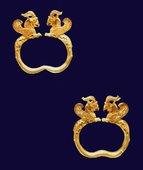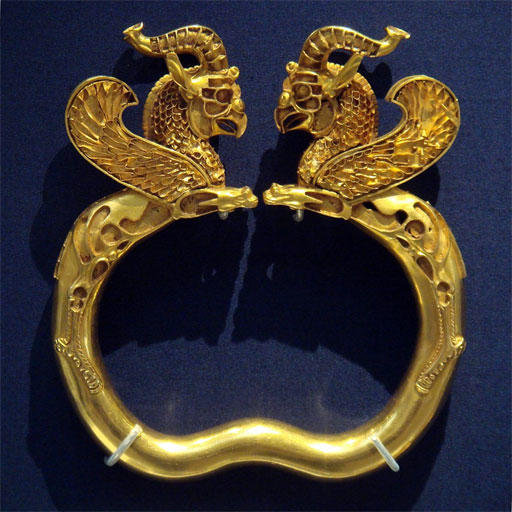The Oxus Treasure was found at the territory of Takht-i Kuwad, Tajikistan, in 1877. It includes a great variety of gold and silver items which belong to the period of the 4th – 2nd centuries BC. Nowadays these items are located in Great Britain in the British Museum and Victoria and Albert Museum.
These treasures reflect the traditions of the art of the Achaemenid period, the peculiarities of the local Greek and Bactrian art, and the elements of the Scythian style. The griffin-headed bracelets are considered as the most famous examples of the Achaemenid art presented in the Oxus Treasure. Today two griffin-headed bracelets are located in the British Museum and Victoria and Albert Museum.

First examples of the Oxus Treasure appeared at the markets of India in the 19th century and attracted the merchants’ attention. The archeologists stated that the treasure was found near the Oxus River. However, there is no factual information about the peculiarities of their discovering.
There are a lot of sources which describe the almost legendary story of the adventures of the treasures in the East (“Gold Griffin-Headed armlet from the Oxus Treasure”). Thus, one story tells about three merchants who were going from Kabul to Peshawar and were stolen by the nomadic people.
They had golden and silver treasures which were bought in Kandiana. The local people had found the items at the coasts of the Oxus River. However, the British Captain F. C. Burton helped them and the golden and silver treasures hidden in small packets were returned to the merchants.
In the morning the muggers came to the Captain because they were frightened with the perspective of being killed. The merchants were grateful to the Captain and asked him to buy the griffin-headed bracelet which is located in the British Museum today (“Gold Griffin-Headed armlet from the Oxus Treasure”).
The golden griffin-headed bracelets became the symbol of the Oxus Treasure which reflect the features of the particular style in making jewelry during the Achaemenid period. If the other items of the treasure belong to the period of the 4th – 2nd centuries BC, the bracelets demonstrate the features of the jewelry art of the 5th-4th centuries BC.
The researchers emphasize that “the bracelets are similar to objects being brought as tribute on reliefs at the Persian centre of Persepolis” (“Gold Griffin-Headed armlet from the Oxus Treasure”).
The practical usage of the bracelets is still studied by the archaeologists and historians who state that these bracelets are impractical and could not be worn by the Persians every day because of the peculiarities of their form and rather massive elements (Dalton). Thus, “the Greek writer Xenophon (born around 430 BC) tells us that armlets were among the items considered as gifts of honour at the Persian court” (“Gold Griffin-Headed armlet from the Oxus Treasure”).
The golden griffin-headed bracelets belong to a long-established Near Eastern tradition which can be characterized by the wide usage of such elements as animal-head terminals (Curtis, Tallis, and Andre-Salvini). Moreover, these bracelets reflect the typical characteristics of usage of polychrome inlays and incrustation.
Today the bracelets are presented without incrustation elements. However, they were originally inlaid with coloured stones and glass (Curtis, Tallis, and Andre-Salvini). To understand the peculiarities of the art of the Achaemenid period, it is necessary to focus on the details of the technique with the help of which the bracelets were made.

All the parts presented in the bracelets were worked out individually with the help of wax models. Thus, the original bracelet is constructed from several parts. The main characteristics of the bracelets are the usage of animal-head terminals as the elements of decoration, polychrome details, and the incrustation of inorganic material (Curtis, Tallis, and Andre-Salvini).
Moreover, the other “element of the design is the relief work, which, depending on the reflection of the light, or its absence in shadowed parts, varies from light to dark, contrasting with the smooth undecorated hoop” (Curtis, Tallis, and Andre-Salvini 135). The most detailed elements of griffins and the wings were also modeled in wax individually. Then wax models were covered with the lays of melted gold (Curtis, Tallis, and Andre-Salvini).
To complete the work, the plastic shaping techniques were used. “The cast metal surfaces of the bracelets and the elements of relief were reworked by plastic shaping techniques, such as chasing, and the use of punches, chisels and a hammer” (Curtis, Tallis, and Andre-Salvini 135). The next stage of the process was the incrustation with glass and coloured stones.
Dalton states that lazuli fragments were also used for the decoration of the bracelets (Dalton). However, to make successful incrustation, it was necessary to fix all the parts of the bracelets. “The ensemble was finally fixed in the depression by means of spurs cut in the rim of the wing” (Curtis, Tallis, and Andre-Salvini 136).
To create the most interesting examples of the Achaemenid jewelry art, the goldsmiths used several metal-working techniques which were professionally combined. “The goldsmiths were specialized professionals with a high level of skill in both artistic and aesthetic terms” (Curtis, Tallis, and Andre-Salvini 136).
Moreover, the researchers state that it was important to have a variety of different tools such as a furnace with bellows, a clay crucible, crucible tongs, and abrasives in order to create such masterpieces of the jewelry art (Curtis, Tallis, and Andre-Salvini).
The golden griffin-headed bracelets from the Oxus Treasure are the most interesting examples which demonstrate the peculiarities of the art of the Achaemenid period in Near East.
Works Cited
Curtis, John, Nigel Tallis, and Beatrice Andre-Salvini. Forgotten Empire: The World of Ancient Persia. USA: University of California Press, 2005. Print.
Dalton, Ormond Maddock. The Treasure of the Oxus: With Other Objects from Ancient Persia and India. USA: Kessinger Publishing, 2010. Print.
“Gold Griffin-Headed Armlet from the Oxus Treasure”. britishmuseum.org. British Museum, n.d. Web.